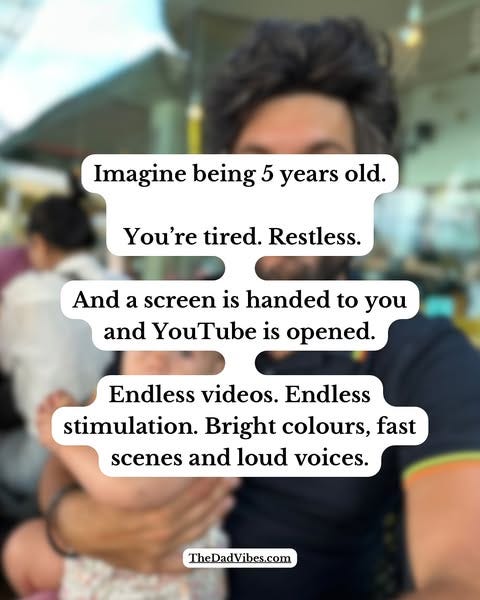Let’s talk about screens, and in particular, YouTube!
YouTube isn’t the enemy, but hours of bright, fast, overstimulating content can take a toll, especially on little brains still learning to self-regulate. Children need connection, movement and imagination.
Screens have their place, and like any other parent, we use them at home. But when they become the main source of comfort or stimulation, we risk wiring our kids to need constant input to feel okay. Let’s teach them how to rest, how to play, and quite simply, how just to be.
Let’s look at things from our kids’ perspective:
Imagine being 5 years old.
You’re tired. Restless.
A screen is handed to you and YouTube is opened.
Endless videos. Endless stimulation. Bright colours, fast scenes and loud voices.
The colours flash and the characters shout.
The next video is loaded and ready before the current one is even finished.
Based on the videos you’ve watched before and the time you’ve spent watching those videos, the algorithm knows the exact video to flood your brain and keep you engaged.
You sit still.
But inside, you’re buzzing.
You don’t know it yet, but you’re going to feel overstimulated.
There’s no end in sight. The next video is loading before the current one is finished.
You’re watching a video whilst scrolling hundreds of others until a thumbnail hits the spot.
But then... The screen is taken away in an instant.
You scream.
You lash out.
And your parent calls you ‘naughty’.
You’re confused.
Your nervous system is dysregulated.
And you don’t have the skills to manage the crash.
Slowly over time, your tolerance for boredom shrinks.
Silence feels uncomfortable.
Slow moments feel unbearable.
You need constant stimulation.
You need a constant dopamine hit.
Real life starts to feel... dull.
What if, instead, someone helped you pause?
Screens aren’t the enemy.
But without limits, they become the default.
And your developing brain needs so much more than passive watching.
Your childhood is made in the quiet moments.
The laughter. The mess. The calm. The play.
This isn’t a post to promote a screen-free home; it’s a post to encourage awareness around the potential impact apps like YouTube can have on the developing brain. I shared this as a post over on Instagram, and the comments are worth a read, so many parents can relate. Often, we can set such a high bar for “behaviour” when it comes to our kids that we lean on devices to keep them busy, then expect blind obedience in an instant.
If you want to explore ways to combat YouTube, paid subscribers can read my post below, which is focused on cultivating healthy YouTube habits in your home…
Healthy YouTube habits
This post is to help you implement healthy YouTube habits within your home. To save you time, if YouTube is a huge problem in your home, and you’re noticing it impacts your child’s behaviour daily, then the safest and most sensible thing to do would be to remove the use of YouTube altogether. Please remember, this guide isn’t to shame screentime, we use screentime, this is to help raise awareness around the use of apps like YouTube that serve our children a continuous and endless stream of content.
Thank you for being part of my community. Feel Good Fatherhood is a reader-supported publication. If you can and value my work, or if you take value in my daily content over on Instagram, please consider becoming a paid subscriber ($5/month), so I can continue to show up and make a positive impact.
Tom Piccirilli, Founder of The Dad Vibes




If I was 5 years old I would be totally addicted to YouTube. Constant excitement and stimulation. Constant challenges. Constant creation. Wow.